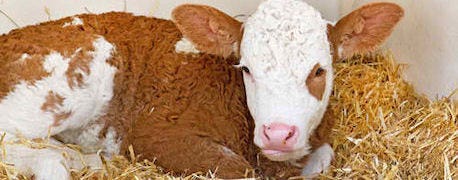March 26, 2014

Cow-calf producers know all too well that proper management and control of disease on the farm or ranch can improve profitability. The same goes for the control of calf scours, which can spread quickly among calves.
Kevin Gould of MSU Extension and Dan Grooms, DVM, MSU College of Veterinary Medicine, say there are a variety of causes of scours in calves, including viruses, parasites and bacteria. Transmission of scours may also take several routes. Learn more about causes and control here: Calf Scours: Learn The Cause, Improve Control.

CHECK FOR SIGNS: Recognizing calf scours early can put calves back on the right track
Aside from prevention – understanding cause and transmission – Gould and Grooms offer tips for recognizing the symptoms of scours and offering treatment if it appears.
Common signs
• Watery stools that may be brown, grey, green, yellow in color. Occasionally blood and mucus may be evident in the stools. Rust colored or very bloody stools are often associated with infection with Salmonella, coccidia, or Clostridium perfringens.
• Calves are often weak and depressed, and may lose their desire to nurse.
• Calves develop a sunken-eyed appearance as a result of dehydration. The bony prominence of their hips, shoulders, and ribs may become more apparent as the calves dehydrate and metabolize their body fat reserves.
• Calves may stagger or sway as they walk; this often reflects weakness, low blood sugar concentrations, and/or alteration of the acid-base balance of their bodily fluids.
• Calves become too weak to stand. Left untreated, death typically occurs within 24 hours.
• Depending on the causes and the severity of the infection, a case of scours in a calf can last 1-2 days or as long as 2 weeks.
~~~PAGE_BREAK_HERE~~~
Recommended treatment
The highest priority in treating scours is to give back to the calf the water and electrolytes that it has lost in scours, the specialists advise. This corrects dehydration, restores normal acid-base balance, and replaces salts in the calf’s bodily fluids. Methods include:
• Oral administration: This option is most appropriate for scouring calves that are still able to stand and who are alert enough to follow their dams and move away when approached. Since most beef calves will not accept being fed by a bottle, water and electrolytes are most often delivered by an esophageal feeder.
Electrolyte powders that have been prepared by veterinary pharmaceutical manufacturers are carefully balanced to provide the correct proportions of salts relative to water for optimal benefit to the calf; these are recommended over home-prepared recipes. Depending on the size of the calf and the severity of the scours, 2-6 quarts of electrolytes may need to be administered each day. Typically, the total volume of fluid is divided into two or more feedings per day.
• Intravenous administration: This route of fluid administration is typically reserved for those calves that are too weak to stand or too lethargic to follow the dam or avoid being caught. The fluids are typically administered through a catheter placed in the jugular vein. Some experienced operators can place a catheter in a scouring calf’s vein; this is most often performed by a veterinarian or veterinary technician. The volume to be given depends on the calf’s size and the severity of the scours.
Limiting Stress: Best Practices for a Successful Calving Season
For a majority of beef cattle producers, spring is calving season. That means a busy time, especially with weather challenges. Planning for all possibilities is the best way to prepare for a successful calving season.
Grooms and Gould also recommend that producers consult with a veterinarian to determine exact treatments and to develop a feeding regimen for scouring calves. Providing bedding and shelter from the elements will also benefit calves. Whenever possible, isolate scouring calves and their dams from healthy cattle, they add.
"It is important to note that some infectious agents that make calves ill can also make people sick. People working with scouring calves should wash their hands before and after handling calves, their feed or their bedding. Practicing proper biosecurity is critical," they note.
A target should be to have no more than 2% to 3% of calves born each year develop scours, Gould and Grooms add.
Source: Michigan State University
You May Also Like




